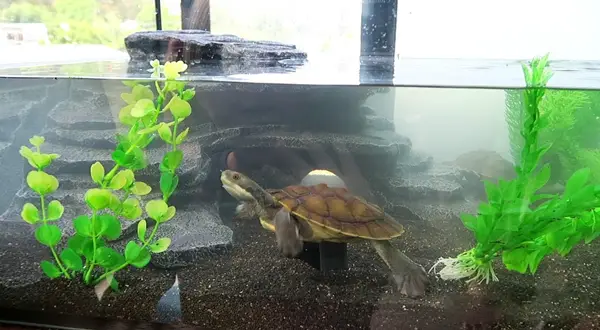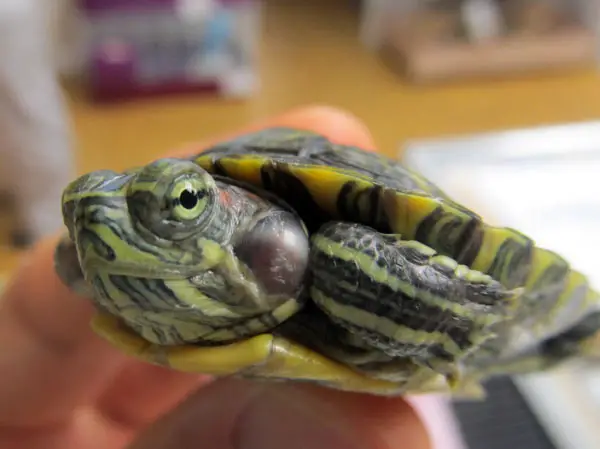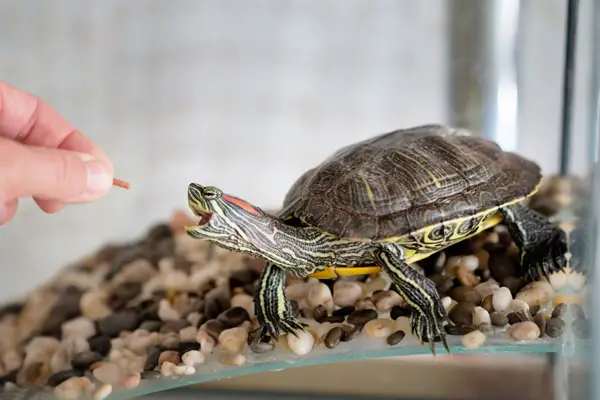How To Tell If Your Turtle Is Sick?
If you’re a turtle owner, you must learn how to give your pet a health checkup to ensure they’re always healthy and happy. You should be able to tell if your turtle is sick without even visiting your vet. But how exactly do you do this?
How to tell if your turtle is sick? You can tell if your turtle is sick by looking out for common illness symptoms like loss of appetite, swollen eyes, runny nose, buoyancy problems or swimming problems, lethargy, and weight loss. Shell defects like abrasions, cuts, sores, etc., are additional signs of a sick turtle.
Discover more details in this guide on how to check the health status of your turtle, what to do if your turtle is sick, and helpful tips on how to keep your turtle healthy and in tip-top condition.
How to tell if your turtle is sick?
Contents
For a new pet owner, it can be hard to tell if your turtle is sick. This is because your pet turtles don’t speak, so they’ll never tell you how they’re feeling.
Plus, they won’t likely exhibit the same sickness symptoms as we humans do, making it even harder for you to know if they’re ailing.

However, you can tell if your turtle is sick by paying close attention to key areas of its body.
Below, we discuss, in detail, how to take your turtle through a health check:
Check the eyes, mouth, and nostrils
One of the areas to focus on when checking your turtle’s health is the eyes. They should be open and clean. They should also be clear of any discharges of crusted materials.
If your turtle has swollen eyes or its eyes are continually held shut, this could be a sign of illness.
Mucous discharge from the eyes or nose usually means the turtle may be suffering from a respiratory infection. Additional symptoms of turtle respiratory illness include open-mouthed breathing and a wheezing, bubbly, or clicking sound when the turtle is breathing.
As for the mouth, a healthy turtle should have a pink color and look smooth. Pale pink or grey color in the mouth is a sign of illness. Patches of green, yellow, or white on the tongue or inside the mouth are additional signs of an illness or mouth rot. Check that the saliva isn’t thick or stringy as this could also mean an underlying condition.
You’d also want to check the head itself as a hole. A swollen head or an asymmetrical jaw (both sides of your pet jaw should look the same) may indicate a metabolic bone disease (MBD).
Lumps and any other forms of swelling on your turtle head may indicate abscesses or signal an underlying illness.
Inspect the shell
Another crucial area to check is the turtle shell. Ideally, the shell of a healthy turtle should feel hard and smooth, with no signs of defects.
If your turtle’s shell has developed abrasions, sores, cuts, etc., they make it highly vulnerable to various infections.
Softshell is a sign that your turtle has a metabolic bone disease.
Look at the skin
Confirm that your turtle has supple skin that’s free of any scratches and bites as these could result in abscesses over time.
The skin of your turtle should look normal, with no signs of irritation, where shedding occurred. But note that a bit of loose skin may hang off during the shedding process.
How does the turtle swim?
If your turtle is having problems with buoyancy (can’t swim correctly), then it could mean it is sick. Most aquatic turtles such as the red-eared sliders, usually do lop-sided swimming when they’re suffering from a respiratory illness.

Lift it up
Hoes does the turtle feel in your hands? The weight is an important aspect to consider. Your turtle should have just the right weight.
It shouldn’t feel too heavy or too low or feel like you’re lifting an empty shell. The reptile should also not show rolls of fat and skin around their legs.
Assess the turtle movements
Lethargy is a sign of an illness in turtles, so you should also check how responsive your pet is. Ideally, you expect your pet to appear alert and responsive.
Watch as your turtle moves around, whether on land or water. It should display a strong and smooth movement. If you notice any weakness or shakiness when it’s moving, your turtle may be sick. Twitches and tremors may also act as an indicator of metabolic bone disease.
When you pick up your turtle, it will most likely pull its legs into the shell. If it appears lethargic and unresponsive instead, it is most likely ailing and weak.
However, remember that land and aquatic turtles may also act lethargic when in brumation mode or when you keep them in cool conditions.
Additional tips for spotting sickness in turtles include loss of appetite. Aquatic turtles tend to cut back on eating and swimming a bit, but a sudden change in their behavior may mean something isn’t right with them.
If you find your turtle ignoring foods, that’s a clear signal that all isn’t well with them. Turtles may also have diarrhea if they’re not feeling at their best.
Generally, any other erratic behavior in your turtle will give you a clue if it has an underlying condition.
We found the helpful video below of a turtle owner taking his aquatic turtles through a health check while pointing out the most important areas to focus on.
How to determine which diseases your turtle is suffering from?
If you discover any of the signs of a sick turtle in your pet discussed above, your most likely course of action is to take them to a reptile vet.
However, you can try to determine which of the common diseases of turtles ailing your turtle at home and its cause. This will depend on the specific symptoms your turtle shows.
For instance, if your turtle’s shell feels extremely soft, it means they’re not getting enough nutrients and you’ll need to adjust their diet.
The underlying skin or undersell getting reddened could also mean a bacterial or fungal infection.
Loss of appetite may have something to do with the water in the tank is too cold. This tricks the turtle’s body into preparing for hibernation.

What if their eyes are squint? That simply means the water is dirty and needs to be cleaned asap. Or it could be that your pet currently lives in tap water and the toxic chlorine this water carries may be irritating their eyes.
If your pet isn’t moving much, it is perhaps because they’re overfed. The turtle may also start swimming around insanely which could be because he/she wants to get out of the water.
Foaming around the nose is a more challenging symptom to help you arrive at any conclusive decision. it could be a respiratory illness, or it could be one of the symptoms of bacterial function.
Simply cleaning your pet’s habitat may not solve all these symptoms. It is, therefore, advisable to always pay your exotic vet a visit whenever your turtle shows any issues with her health.
TIP: We recommend keeping a thorough list of all the symptoms your turtle has. Present them to your vet to help them easily diagnose the condition ailing your little friend.
How do you treat a sick turtle at home?
Whenever your turtle shows any signs of sickness, you should try and race against time to save them. Else, if you don’t act fast, it might be too late for your little friend. This is especially true given that the symptoms you noticed may be surfacing when it’s too late.

Follow the procedure below to treat and take care of your sick turtle:
Step 1. Take a small empty terrarium (a large container, e.g. a bucket will also work) and fill it with water up to 2-3 inches. Bring the water up to an appropriate level depending on the type and size of turtle you have.
Step 2. Place the container atop a heating pad. You can also use any other heat source; just make sure the heat comes from outside the container, not inside.
Step 3. Put a drop of de-chlorinating formula into the water.
Step 4. Add a sulfa block into the water. This will provide your turtle with essential minerals and vitamins even if she’s not eating.
Step 5. Adjust the water temperature. Ensure the temperature doesn’t get any higher than 86 degrees F and not less than 82 degrees F. After the temperature is ideal, put your turtle inside.
Step 6. Put a UVB light overhead the terrarium to provide your pet with vitamin D3, which is essential for their health.
Step 7. Monitor the temperature regularly. Change the water twice a day (say in the morning and at night) to help wash away any bacteria coming from their mouth.
Step 8. You may also consider covering the aquarium walls with towels to keep your pet from panicking whenever you or your visitors pass by.
BONUS Step: If you think an infection is to blame for your turtle’s sickness, you may also want to reach out to your vet and ask for the right medicine to treat your turtle with.
Keep your pet in the new habitat for days as you monitor his behaviors. They’ll eventually regain their normal body function and the sickness will be gone.
However, you may try all this but your turtle still dies. This is probably because you noticed the signs when it was too late or your turtle had more than just an infection.
If the worst happens, don’t feel bad because you at least have given your pet a fighting chance by taking good care of them.
Dying or brumation: How to differentiate the two
Many pet owners with little experience with turtles tend to confuse brumation (or hibernation) with a sick or even dead turtle. This is because, during this phase, the animals naturally stop eating and show highly lethargic behavior.
The turtle’s metabolism significantly slows down to enable them to sleep through the cold winter months.

If you’re never sure whether your turtle is bromating, you’d want to take your pet to the reptile vet.
They’ll examine it to confirm that the turtle is indeed brumating and not sick or dying. You’ll also get to learn from the professional the specific needs of your pet during these months.
How do I make sure my turtle stays healthy?
Turtles are one of the longest-lasting pets you can get, just like their cousins the tortoises, and can be your buddy for as many as 50 years. However, your turtle getting sick can cut down their lifespan, so it’s important to give them the best care to ensure they stay healthy at all times.
One of the best ways to make sure your turtle stays healthy is by feeding them nutritious foods. Turtles require proteins, which means you must feed them with live fish and other meat options such as insects.
Keeping your turtle’s habitat clean will also help keep away illnesses. Poor environment conditions like keeping your turtle in crowded and unsanitary conditions will make them prone to stress and illnesses. Keep their habitat, both water and land, free of any leftovers and leavings that encourage bacteria and bugs.

Take care of your pet’s mental needs as well. Keep them entrained with games and items that keep them sharp, prevent boredom, and decrease the chances of getting stressed.
One more thing: Take your pet to the vet regularly. You may consider making annual visits to the vet. During these visits, the vet will assess your pet’s overall health and suggest any modifications in your turtle care to help keep it healthy.
Related questions (FAQs):
Your turtle not moving or eating for days may indicate that they’re suffering from respiratory illnesses, diet deficiencies, lack of appetite, parasitic infections, and other common turtle illnesses. You may want to try feeding your turtle different types of food. If this still doesn’t work, consider taking them to the vet.
A healthy turtle shell should be hard and smooth, with no defects. If your pet’s shell has cuts or scratches, it means they could get infected easily. A soft shell could be a sign of metabolic bone disease. A cracked or broken shell means your turtle is suffering from a serious injury and you should visit your exotic vet as soon as possible.
You can tell if your turtle has pneumonia or respiratory diseases if they occasionally produce bubbles of mucus from their nostrils. Bubbles around the eyes could be another sign. Floating oddly in the water, lopsided swimming, and being unable to submerge may also hint at a respiratory infection in turtles.
Final Word
Now you know how to tell if your turtle is sick. The procedure is pretty simple and involves checking for key symptoms like loss of appetite, swollen eyes, buoyancy problems, lethargy, runny nose, and shell and skin defects.
Whenever you notice these signs of illness in your pet turtle, follow the procedure we have discussed in the above guide to take care of your pet at home. And hopefully, they’ll recover from the illness.
You can keep your pet healthy and free of illnesses by cleaning your pet’s habitat, giving them nutritious food, keeping them happy and entertained, and taking them to the vet for regular examinations.


